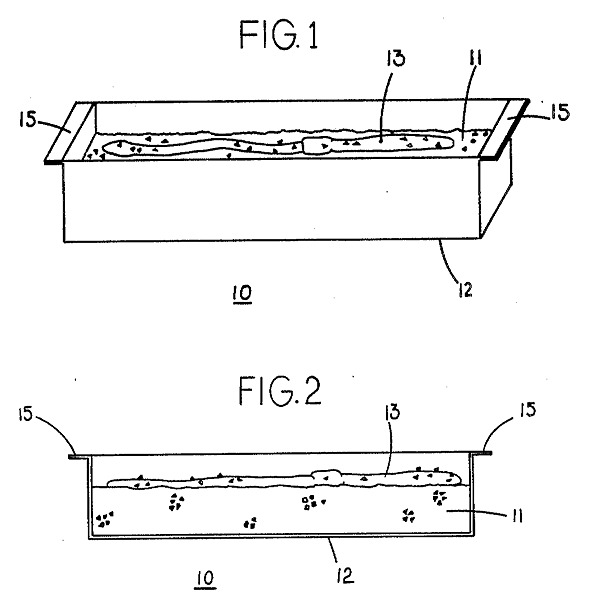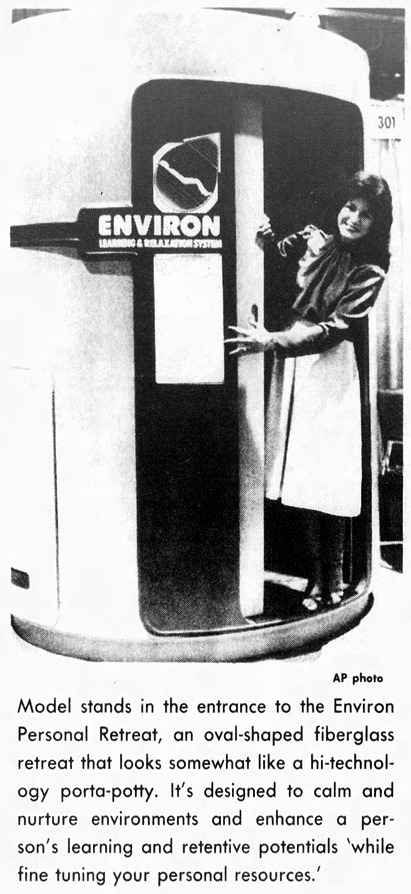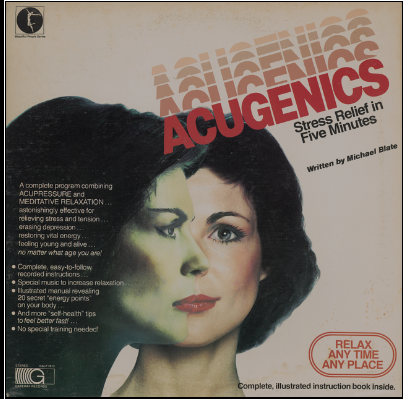1980s
The Human Performance Enhancing Robot of Dr. NakaMats
AKA Cerebrex. Invented by Dr. Yoshiro NaKaMats. It was essentially a lounger chair that was supposed to improve brain function in only 30 minutes. Details from the Arizona Republic (Sep 12, 1986):Meanwhile, customers can use it only in his sun-flooded "oyasumidokoro," or sleeping place, a nearly empty room a few floors below his laboratory, where white-coated assistants bustle around prototypes of industrial robots in various stages of development.
The inventor explains how the chair works, sort of.
"It activates your alpha brain waves by emitting ultra-high frequency electronic pulses, which in turn increase the flow of blood to the head, through the chair's pillow and foot rest," he said.

York Dispatch - July 2, 1986
You can check out a (non-embeddable) video about Cerebrex on Vimeo.
Posted By: Alex - Fri Aug 21, 2020 -
Comments (5)
Category: Inventions, 1980s, Brain
Unauthorized Dwellings 14




Source.
Posted By: Paul - Mon Aug 17, 2020 -
Comments (2)
Category: Charities and Philanthropy, Family, Unauthorized Dwellings, 1980s
RIP Chicken Fried Steak
On July 26, 1985, the Taste of Texas restaurant in Houston buried a chicken fried steak and put up a tombstone for it, which remains there to this day.
It reminds me of the grave of Blinky the frozen chicken in L.A.
via Click2houston
Posted By: Alex - Tue Jul 21, 2020 -
Comments (0)
Category: Death, Food, 1980s
Apparatus for temporarily immobilizing earthworms
Worms wiggle. This can make it hard for fishermen to impale them on a hook. But in 1989, Loren Lukehart of Boise, Idaho offered a solution. He received a patent (No. 4,800,666) for a method of "dewiggling" earthworms.His invention was essentially a rectangular box full of sand. From his patent:
Once the sand coated earthworm is immersed in water, the sand rinses free and the earthworm resume its normal wiggly character.

Posted By: Alex - Sun Jun 28, 2020 -
Comments (0)
Category: Inventions, Patents, Sports, 1980s
B.A.D. Cats
Lasted for 6 episodes, according to Wikipedia.
Posted By: Paul - Thu Jun 25, 2020 -
Comments (4)
Category: Crime, Ineptness, Crudity, Talentlessness, Kitsch, and Bad Art, Motor Vehicles, Television, 1980s
The Environ Personal Retreat
The Environ Personal Retreat, sold by the Environ Corporation in the early 1980s, was designed to be a stress-free, self-improvement chamber. It offered programs such as "Relax and Affirm," "You and Food: New Scenarios," and "Self-Motivation for Winners." It came with a hefty price tag, $9000, but it was marketed at businesses, with the idea that they could de-stress and motivate their employees. Details from the LA Times - Nov 17, 1982:Seated inside this exotic lounger, the user chooses one of 36 taped 20-minute human-potential programs, and the machine goes into action.
Ionized, filtered air is piped in, along with a pleasing natural scent. And while the taped verbal and music program plays, colored lights change in time with the text. If the user is listening to a business talk on self-motivation, for example, the capsule is bathed in stimulating orange and red lights. On the other hand, if the program deals with relaxation or stress reduction, the lighting is in soothing hues of green and blue.

White Plains Journal News - Jan 23, 1983
Posted By: Alex - Mon Jun 22, 2020 -
Comments (4)
Category: Business, Technology, 1980s
What a Country!
This is a show that could bring the nation together again.Wikipedia page.
Posted By: Paul - Tue Jun 16, 2020 -
Comments (3)
Category: Education, Stereotypes and Cliches, Television, Foreign Customs, 1980s
Acugenics

Learn how to acugenics yourself here.
Posted By: Paul - Sat Jun 13, 2020 -
Comments (1)
Category: Self-help Schemes, 1980s
Jan Švankmajer’s “Dimensions of Dialogue”
Filmmaker's Wikipedia Page.
Posted By: Paul - Tue Jun 09, 2020 -
Comments (3)
Category: Antisocial Activities, Body, Movies, Stop-motion Animation, Surrealism, 1980s, Eating
The Animan
It's now 2020. Where are our bipedal TVs?

Source: Popular Science - June 1988
Posted By: Alex - Mon Jun 08, 2020 -
Comments (7)
Category: Inventions, Television, AI, Robots and Other Automatons, 1980s

| Who We Are |
|---|
| Alex Boese Alex is the creator and curator of the Museum of Hoaxes. He's also the author of various weird, non-fiction, science-themed books such as Elephants on Acid and Psychedelic Apes. Paul Di Filippo Paul has been paid to put weird ideas into fictional form for over thirty years, in his career as a noted science fiction writer. He has recently begun blogging on many curious topics with three fellow writers at The Inferior 4+1. Contact Us |




